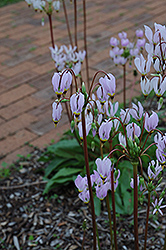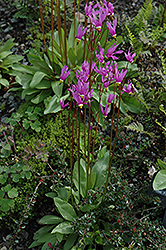Plant Height: 4 inches
Flower Height: 12 inches
Spread: 6 inches
Sunlight:
![]()
![]()
![]()
Hardiness Zone: 2b
Description:
A mid-spring blooming selection that features erect, arching stems of unusual and unique recurved white and pink flowers with brown or yellow centers; lovely in borders, beds and rock gardens before going summer dormant
Ornamental Features
Shooting Star features dainty nodding pink recurved flowers with yellow eyes at the ends of the stems in mid spring. Its pointy leaves remain dark green in colour throughout the season.
Landscape Attributes
Shooting Star is an herbaceous perennial with tall flower stalks held atop a low mound of foliage. Its medium texture blends into the garden, but can always be balanced by a couple of finer or coarser plants for an effective composition.
This is a relatively low maintenance plant, and is best cleaned up in early spring before it resumes active growth for the season. It is a good choice for attracting bees to your yard, but is not particularly attractive to deer who tend to leave it alone in favor of tastier treats. It has no significant negative characteristics.
Shooting Star is recommended for the following landscape applications;
- Mass Planting
- Rock/Alpine Gardens
- Border Edging
- General Garden Use
Planting & Growing
Shooting Star will grow to be only 4 inches tall at maturity extending to 12 inches tall with the flowers, with a spread of 6 inches. It grows at a slow rate, and under ideal conditions can be expected to live for approximately 10 years. As an herbaceous perennial, this plant will usually die back to the crown each winter, and will regrow from the base each spring. Be careful not to disturb the crown in late winter when it may not be readily seen! As this plant tends to go dormant in summer, it is best interplanted with late-season bloomers to hide the dying foliage.
This plant performs well in both full sun and full shade. It requires an evenly moist well-drained soil for optimal growth. It is not particular as to soil pH, but grows best in rich soils. It is quite intolerant of urban pollution, therefore inner city or urban streetside plantings are best avoided. This species is native to parts of North America.
Disclaimer - This resource is provided for informational purposes only and does NOT reflect current availability. Inventory varies seasonally, so we cannot guarantee that every plant will be in stock at all times - please contact your favourite GardenWorks location directly for current availability. It does not include our entire inventory of plants, so be sure to visit GardenWorks to see varieties that may not be represented on this list.


